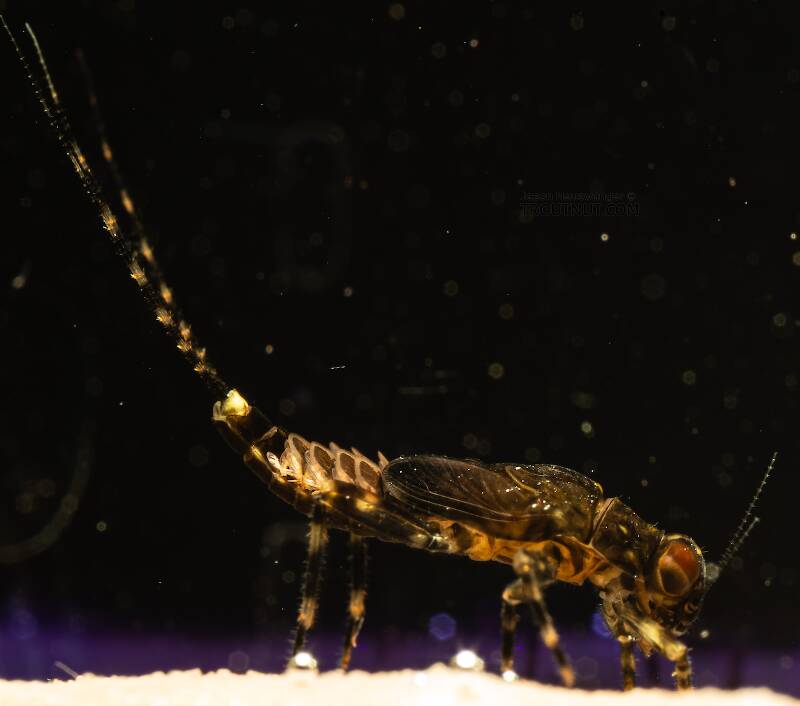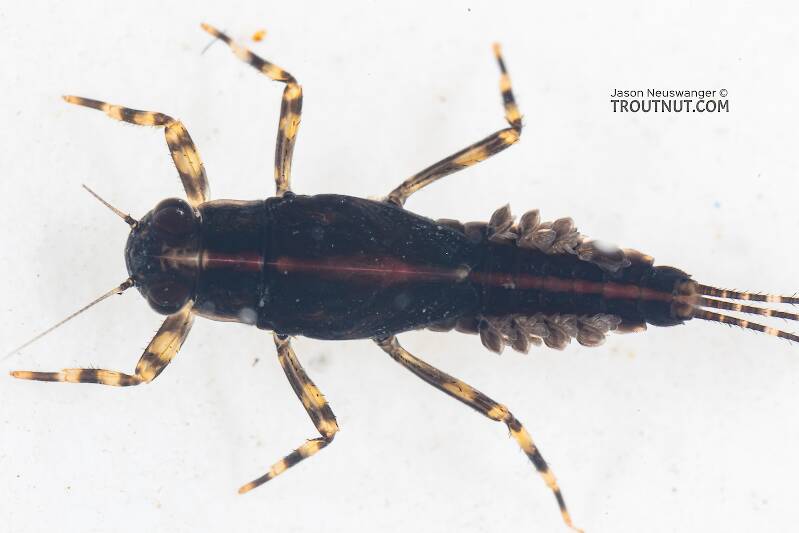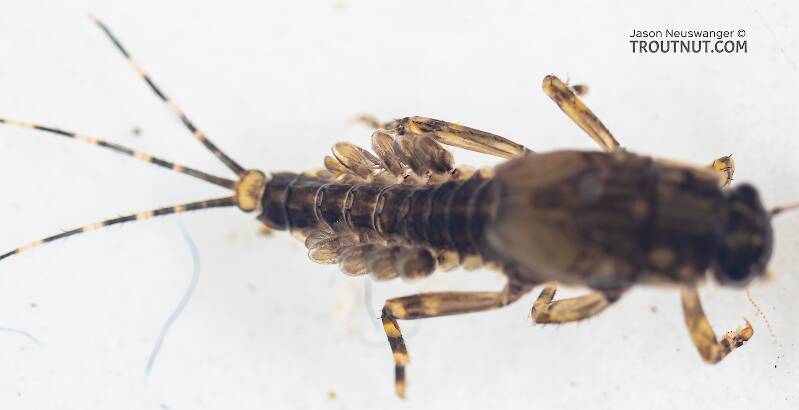
Hex Mayflies
Hexagenia limbata
The famous nocturnal Hex hatch of the Midwest (and a few other lucky locations) stirs to the surface mythically large brown trout that only touch streamers for the rest of the year.
Featured on the forum

This seems to be a young larva of Limnephilus. Although not clear in the picture, several ventral abdominal segments have chloride epithelia.

Troutnut is a project started in 2003 by salmonid ecologist Jason "Troutnut" Neuswanger to help anglers and
fly tyers unabashedly embrace the entomological side of the sport. Learn more about Troutnut or
support the project for an enhanced experience here.
This topic is about the Mayfly Genus Serratella
Prior to recent revisions, this genus of elegant little dark mayflies with their small dark bodies, dark slate wings, and paler legs and tails was more important to anglers. What was the East's most significant species is now known as Teloganopsis deficiens (Little Black Quill). The only remaining species reported of value to the eastern angler is Serratella serrata (Little Sooty Olive).These changes have had an even bigger impact in the West. The significant Summer hatching tibialis has been moved back to its old genus and is again called Ephemerella tibialis (Small Western Dark Hendrickson). The next most prominent species (though of only minor importance) is now called Matriella teresa and is the only recognized species of that genus in North America. The very minor species velmae has also been moved, and is now back in Ephemerella. This leaves only a few western species in this genus, and they are of no reported significance to anglers.
Example specimens
Martinlf on Jun 10, 2009June 10th, 2009, 3:18 pm EDT
Does anyone know the color of the emerging/freshly emerged dun?
"He spread them a yard and a half. 'And every one that got away is this big.'"
--Fred Chappell
--Fred Chappell
Taxon on Jun 10, 2009June 10th, 2009, 4:06 pm EDT
Louis-
Ask, and ye shall receive:
Scientific name: Teloganopsis deficiens
Previously know as: Ephemerella atrescens, Ephemerella deficiens, Serratella deficiens
Dun body description: dark reddish to blackish brown w/dark red eyes
Dun wings: dark gray to blackish, hind wings w/pronounced costal angulation
Dun legs: white to creamy tan
Dun tails: 3, cream to amber
PS. I understand what you are doing, and salute it!
Ask, and ye shall receive:
Scientific name: Teloganopsis deficiens
Previously know as: Ephemerella atrescens, Ephemerella deficiens, Serratella deficiens
Dun body description: dark reddish to blackish brown w/dark red eyes
Dun wings: dark gray to blackish, hind wings w/pronounced costal angulation
Dun legs: white to creamy tan
Dun tails: 3, cream to amber
PS. I understand what you are doing, and salute it!
GONZO on Jun 10, 2009June 10th, 2009, 4:34 pm EDT
Although all of the deficiens duns that I have seen in hand were quite black in the body and wings, I suspect that there is some darkening after emergence. Perhaps a brownish shade would be good for an emerger as there is a hint of brown in the bellies of the duns. The wings would probably still be blackish.
Like Roger, I applaud your effort to overcome your insect-induced frustrations. I hope the new pattern works well for you.
Like Roger, I applaud your effort to overcome your insect-induced frustrations. I hope the new pattern works well for you.
Konchu on Jun 11, 2009June 11th, 2009, 9:33 am EDT
I've even seen some that were almost a dark burgundy or purple. Very beautiful.
Martinlf on Jun 11, 2009June 11th, 2009, 3:03 pm EDT
Cool, thanks Konchu.
"He spread them a yard and a half. 'And every one that got away is this big.'"
--Fred Chappell
--Fred Chappell
JAD on Jun 11, 2009June 11th, 2009, 4:53 pm EDT
Hi All
The above mentioned ---(Dun wings: dark gray to blackish, hind wings w/pronounced costal angulation
Dun legs: white to creamy tan
Dun tails: 3, cream to amber)
That description is dead on, I have only seen the fly on very quiet water, with the trout feeding a normal dry fly rise. I have never seen one escape from the surface or emerge .
JAD
The above mentioned ---(Dun wings: dark gray to blackish, hind wings w/pronounced costal angulation
Dun legs: white to creamy tan
Dun tails: 3, cream to amber)
That description is dead on, I have only seen the fly on very quiet water, with the trout feeding a normal dry fly rise. I have never seen one escape from the surface or emerge .
JAD
They fasten red (crimson red) wool around a hook, and fix onto the wool two feathers which grow under a cock’s wattles, and which in colour are like wax.
Radcliffe's Fishing from the Earliest Times,
GONZO on Jun 11, 2009June 11th, 2009, 5:16 pm EDT
When I read about Woody41's "little black bug" in the "Looking for some info.." thread, I wondered if that might be another encounter with deficiens. Perhaps the photos will come up soon. Eastern fly fishers are often surprised by this relatively unheralded species at this time of the season. Midwesterners seem to be a bit more familiar with it, at least enough to give it the Darth Vader nickname.
Quick Reply
Related Discussions
Topic
Replies
Last Reply
Re: Will the real Ephemerella needhami please stand up? Featured Topic
In Male Ephemerella needhami Mayfly Dun by GONZO
In Male Ephemerella needhami Mayfly Dun by GONZO
17
Feb 26, 2016
by Martinlf
by Martinlf
4
Dec 22, 2009
by Oldredbarn
by Oldredbarn








